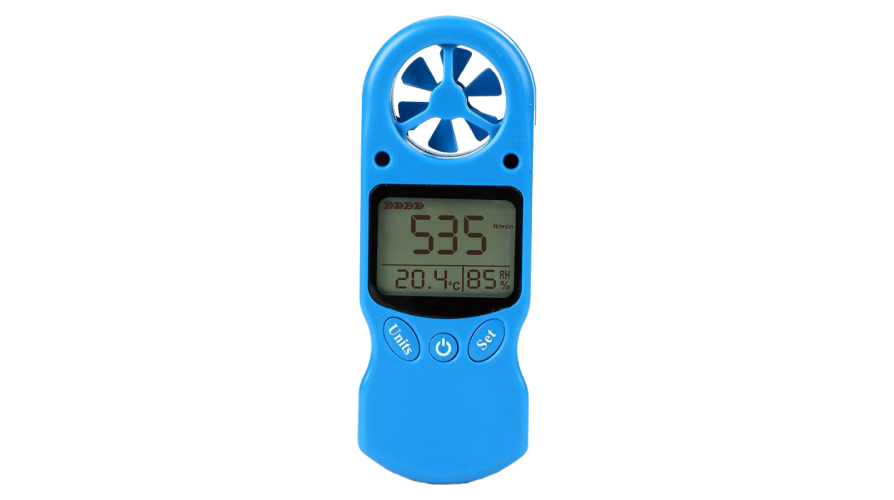The Role of an Anemometer in Improving Safety for Outdoor Activities
The Role of an Anemometer in Improving Safety for Outdoor Activities
Blog Article
All You Required to Know Concerning Anemometers: Exactly How They Work, Why They Issue, and Where to Utilize Them
Anemometers, though frequently ignored in the world of scientific tools, play a crucial duty in various areas, offering valuable insights right into wind speed and airflow patterns. Understanding the technicians behind these devices is essential for any person seeking to harness the power of this information. From meteorologists tracking weather patterns to engineers making structures with wind lots in mind, the applications of anemometers are diverse and significant. As we dive right into the complexities of anemometer technology, we will reveal the inner workings of these gadgets, their importance, and the key factors to consider when picking the best anemometer for certain applications.

Anemometer Essentials
An important instrument made use of to measure wind speed and direction, the anemometer plays an important duty in weather forecasting and numerous markets. An anemometer normally is composed of three or 4 cups that revolve in the wind, a vane that directs into the wind, and sensors to track the turnings or motions. By determining the rotations or activities over a certain period, the anemometer can identify wind rate. The vane assists identify wind instructions by directing into the wind, offering beneficial information for weather projecting, air travel, maritime operations, ecological monitoring, and wind power applications.
There are various kinds of anemometers available, consisting of cup anemometers, vane anemometers, hot-wire anemometers, and sonic anemometers, each with its special features and applications. Cup anemometers are commonly utilized for standard wind speed measurements, while vane anemometers are preferred for directional measurements. Hot-wire anemometers are ideal for low airspeeds, and sonic anemometers are suitable for high-precision measurements in research study and commercial settings. Comprehending the basics of anemometers is crucial for precise wind information collection and evaluation across different fields.
Concepts of Anemometer Procedure
Building on the foundational understanding of anemometer basics, the principles of anemometer operation illuminate the technicians behind wind speed and direction dimensions. Anemometers run on the concept of airflow impacting a sensor, causing it to rotate. Cup anemometers, for example, have three or more cups that capture the wind, triggering them to rotate much faster as the wind speed boosts. The turning speed is then converted into a wind speed measurement. Vane anemometers, on the various other hand, utilize a tail or a probe that aligns itself with the wind direction, offering a dimension of wind instructions based upon the positioning of the sensor. Hot-wire anemometers depend on a heated cable that cools as wind passes over it, with the price of cooling down identifying the wind speed. Ultrasonic anemometers procedure wind rate and direction by assessing the time it considers ultrasonic signals to take a trip in between transducers. Recognizing these concepts is crucial for accurate and reputable wind dimensions in various applications. published here
Value of Anemometers
The relevance of anemometers in weather forecasting and different industries can not be overemphasized. Anemometers play a critical function in measuring wind rate and direction, offering necessary data for climate forecasting, environment studies, ecological monitoring, and air travel procedures. Meteorologists rely upon anemometers to collect accurate wind information, helping them comprehend weather patterns, forecast storms, and concern timely cautions to the public. In markets such as construction, agriculture, renewable resource, and maritime procedures, anemometers are utilized to maximize processes, make sure safety and security, and raise effectiveness. As an example, wind ranch operators use anemometers to assess wind conditions and make why not check here best use of electrical energy production from wind generators. In the maritime field, anemometers aid ship navigation by giving real-time wind information to captains, assisting them make notified choices to guarantee risk-free trips. On the whole, anemometers are important devices that add dramatically to safety, efficiency, and informed decision-making in meteorology and a variety of sectors.
Applications Across Numerous Industries
In the eco-friendly power field, anemometers play an important function in examining wind problems for wind ranch placements, guaranteeing optimum energy production. Industries like building and mining use anemometers to keep an eye on wind rates, vital for safety and security protocols, specifically when functioning at elevations or in open-pit mines where strong winds can position risks. In agriculture, anemometers aid farmers in taking care of crop spraying by giving real-time information on wind speed to avoid drift.

Selecting the Right Anemometer for Your Demands
Selecting the suitable anemometer tailored to your certain needs is essential for getting accurate wind speed and direction measurements. When choosing an anemometer, think about aspects such as the intended application, required dimension range, ecological problems, and preferred functions. For basic objectives, a mug anemometer appropriates for measuring wind speed, while a vane anemometer provides wind direction information. Hot-wire anemometers are perfect for low airspeed measurements, and ultrasonic anemometers offer high accuracy and resilience.

Final Thought
In conclusion, anemometers play a vital role in measuring wind speed and instructions throughout numerous markets. It is vital to think about the significance of anemometers in order to make enlightened choices when choosing the most appropriate tool for determining wind problems.
There are various kinds of anemometers available, including mug anemometers, vane anemometers, hot-wire anemometers, and sonic anemometers, each with its special functions and applications. Cup anemometers are commonly used for standard wind speed measurements, while vane anemometers are chosen for directional dimensions. Hot-wire anemometers are appropriate for low airspeeds, and sonic anemometers are perfect for high-precision measurements in research and commercial setups.Building on the fundamental understanding of anemometer fundamentals, the principles of anemometer procedure elucidate the auto mechanics behind wind speed and instructions measurements. For general objectives, a mug anemometer is appropriate for determining wind speed, while a vane anemometer offers wind instructions data.
Report this page